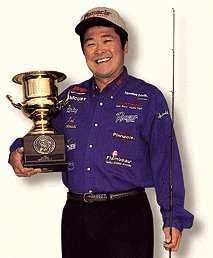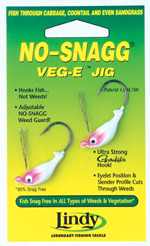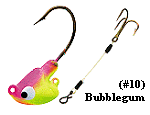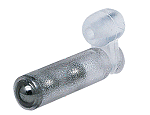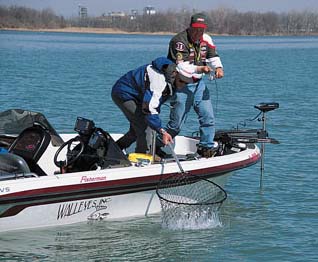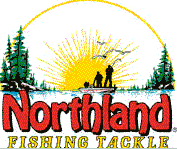
|
|||||||||||||||||||||||||
|
Promotional Team Favorites Lodging food and more 
Free 90 day Risk free trial offer click here 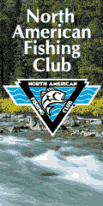
|
By Doug Newhoff with Fishing the WildSide Long before there were rattling crankbaits, holographic spinner blades, and scented plastics, the simple jig occupied a prominent place in every tackle box. Some things never change, and any angler worth his or her lead continues to hold jigging in high regard. It's a time-tested method for catching walleyes in a variety of conditions. From clear to stained water, cold to warm water, and current to slack water, a properly presented jig puts fish in the boat. The verb "jigging" implies an action imparted by the angler, bringing something as innate as a piece of lead and hook to life. And few fishing experiences compare to the feel of a walleye when it snatches a jig on the upswing. Jigs are also one of angling's most versatile tools. You can cast a jig, flip a jig, pitch a jig, bounce a jig, twitch a jig, wiggle a jig, drag a jig, and even troll a jig. You can fish jigs deep or shallow. You can dress a jig up by adding plastic or live bait. Or, you can undress a jig when fish seem sluggish, uninterested. If there is one constant, though, which is always in the angler's favor, it's a walleye's need to eat and do so while exerting as little effort as possible. Ask not what a jig can do for you, but what you can do for a jig. On a greater scale, it pays, literally, for tournament anglers to be proficient in the art of jig fishing. Sometimes, that means modifying traditional presentations or even creating new methods of coaxing neutral or negative walleyes to bite. In 1996, John Peterson won a Professional Walleye Trail event on Lake
of the Woods. In 1998, Ted Takasaki won the PWT Championship on the Missouri
River. And in 2001, Fishing the Wildside’s Tommy Skarlis captured a PWT
event on the Detroit River. All three anglers won by evaluating conditions
and implementing an effective jigging approach. They also won using products
developed by their sponsors. Peterson, Takasaki, and Skarlis recently shared
some insights and expertise in a series of interviews.
Rule number two is to vary jig colors and styles. If I've got four people in the boat, we'll start off with four different colors and try to determine what the walleyes want. As far as bait, the general rule is minnows in the spring and fall, nightcrawlers pretty much year-round, and leeches in the summer when the water temperature is above 55 degrees. I try to mix that up, too, to see if one is working better than another. Rule number three is to vary the action. It might be a drag-and-stop, a traditional lift-and-drop, or just a quick pop. I've had situations in cold water where all they wanted was a little quiver. I'd also suggest maintaining sharp hooks and using stinger hooks if you're getting a lot of short strikes. And tie the line directly to the jig. As far as fishing a jig, one of the most important things you can do is watch the line. A lot of times you see the line move to the side or jump or twitch before you even feel the fish. Watching the line also allows me to determine whether I'm on the bottom or not. Before I actually feel the bottom, the line relaxes. Q) How did you win the Championship in North Dakota? A) It was a combination of location and presentation. We were on the Missouri River system near Bismarck, ND, in autumn. The walleyes were moving out of the river into the creek arms, following baitfish. They were concentrating on outside bends and deeper holes inside those creek arms. Water clarity was only about four or five inches. I found that a hot yellow, glow-in-the-dark Fuzz-E-Grub was the key. It provided visibility and bulk. Walleyes could find it. Q) A lot of people were jigging in that tournament. What separated you from the rest? A) I think it was the combination of four things – color, weight, bulk, and location. There were probably 10 of the 40 guys fishing various creek arms. I was using slightly heavier jigs than most of them – quarter and three-eighths ounce. I think that really made a difference when the wind blew, because the walleyes seemed to want the jig stationary and tight to the bottom. A lot of times I'd drop the jig straight to the bottom, and when I picked it up, a fish was on. Most guys I talked to were using 1/8th and 1/16th ounce jigs, too light of tackle. Q) Is there any better feeling than winning a major walleye tournament using a product you promote? A) Winning that Championship gave me a feeling money can't buy. It's a sense of accomplishment, something you can hang your hat on and tell your grandkids about. It truly was an exhilarating experience. JOHN PETERSON, 1996 Lake of the Woods PWT Winner Q) What is it that makes jig fishing your favorite presentation? A) It's the sensation. Nothing else compares. There's a direct and short link between you and the fish. When I go to strange bodies of water, I'll search for walleyes using my locator and presentations like crankbaits or spinner rigs to cover ground quickly. But if I can find pockets of fish, I'll go back and zero in on them with jigs. Jigging is an in-your-face presentation that will catch fish in all
sorts of conditions, including cold fronts when you can't catch fish on
horizontal presentations. It's a way to stay small, too, and I think day
in and day out, smaller presentations out-produce larger presentations,
such as crankbaits and spinners. Plus, you can catch big fish with a jig.
Big fish get pretty lazy. They don't like to chase and exert a lot of energy.
Q) What are some of your rules of thumb regarding color selection? A) The standard guideline is to use the brighter, fluorescent colors in stained or dirty water, or even overcast conditions. For me, that means orange, chartreuse, or some combination, like a two-tone jig with chartreuse and green or chartreuse and orange. In clear water, I prefer more subtle colors like white, black or blue. If I'm fishing the warm-water period when there's some kind of algae bloom, a lot of times the water has a green tint to it. Then I love a jig that has some green in it. Q) What makes one jig fisherman better than another? A) I think a lot of it has to do with touch. To me, it's real personal
because there are a lot of techniques that trigger strikes. Fish have attitudes
just like people. Some days fish want it slow and subtle, other days they
want it ripped or moving fast. I really pay attention to fish moods. Once
you start forcing a technique on fish you’re in trouble. Be observant of
other fishermen, too. See what they might be doing differently. You've
got to have an open mind to be successful. You've got to be willing to
change.
Q) How rewarding is it to win a major tournament with a lure you helped develop? A) That was very satisfying because we had just developed the Buck-Shot. It was the first major tournament where I was able to use it, and I found the perfect situation to use it. When I went to fish the PWT at Lake of the Woods, Buck-Shots were part of the plan, but a lot of times the plan falls to pieces and you end up going back to your old, reliable ways. This was one of the most gratifying tournaments I've ever fished because the plan I wanted to implement actually worked without having to deviate from it. TOMMY SKARLIS, 2001 Detroit River PWT Winner
A) I grew up as a river rat fishing on the Mississippi. Jigging was all we used to do. I think one of the biggest keys is to know where your jig is and what it's doing at all times. Jig fish are usually located near the bottom. Lead heads take us there and keep us in the strike zone. Finding out what's going to trigger strikes is very important. Some people retrieve jigs with a steady retrieve while it's bouncing across the bottom, or they vertical jig with one certain stroke. I think it's vital to change up or mix up your retrieve or cadence to find out what will trigger strikes on a given day. That means you have to pay attention to what you're doing. It doesn't do you any good if you change up and catch a fish, then can't remember what changes you made.
A) Too often, people think they've got to fish with really light jigs no matter what. My rule of thumb is to go as heavy as needed to remain in contact with the bottom. On the other side of the coin, sometimes they don't go light enough. If you're casting in a lake with a lot of moss or submergent vegetation, a jig that's too heavy will sink and slime up. Then it's worthless. That's a case when lighter is better. When I'm casting jigs, one of my favorite things to do is to lift the jig or pop it off the bottom by just moving the rod tip about a foot and a half from the nine o'clock position to the eleven o'clock position, then hold it steady to allow the jig to glide back toward the bottom at a 45-degree angle. In weeds, you can sometimes drag a jig through the leaves and not catch any fish. But if it happens to hang up a little bit and you pop it free, you’ll entice a strike.
Q) Has jig fishing changed for you over the last 20 years? A) Not so much the way I fish jigs, but the jigs I fish with have changed. It's unbelievable. Back when I was a kid, most jigs had cheap finishes that chipped off and color selection was limited. They had small, soft hooks, and there were only three or four head styles. Now we've got glow colors, two-tone colors, prism finishes ... Jigs are more durable, too. They come with high quality, ultra sharp hooks. A lot of companies are making their jigs with bigger hooks, too, for walleye anglers. It used to be that if you had to fish a 1/32nd ounce jig, you were going to fish something with a crappie hook in it and take your chances hooking and holding walleyes. Now they're making them with walleye hooks. There are also head styles out there to deal with all kinds of situations, whether it's wood, rock, weeds or whatever. For example, the No-Snagg Veg-E-Jig and Timb’r Rock Jig from Lindy are allowing us to dance jigs and pull fish from structure that was once almost impossible to fish. Q) What made the difference for you on the Detroit River last spring? A) When I won the Detroit River tournament, we were vertical jigging while slipping with the current. The fish didn't want a jig that was hopping radically. They wanted it gliding a couple of inches off the bottom. They were really finicky. I settled on a technique where I'd tap the bottom with the jig every once in awhile or snap it and hop it, then go back to gliding to entice the strike. I had four or five little things I did between glides, and sooner or later they'd see something they liked and whack it. It wasn't just the way I was jigging, either. I also know that using Berkley's six pound test, two pound diameter flame green Fireline was a huge factor. It gave me visibility that helped me see more hits and because of the rock structures we were fishing around, you needed the responsiveness a no-stretch line gives. Another trick was positioning the boat so the trolling motor was always downstream from my rods. That way the transducer on the trolling motor would show me the rocks before my jigs got there, and I could lift them up and over. When I'd notice the bottom dropping again, I'd follow the drop down the backside and let them glide along. Most of my hits occurred either in front of or behind those rock piles. Knot placement was important, too. I tried to position the knot so the jig rode horizontally with the hook riding even a little high just to keep it out of the snags. We were also using big shiners, four or five inchers and putting a Lindy stinger snell on the hook and imbedding it in the meaty part of the tail. Three or four of the key fish that I weighed in were just barely hooked in the lip by the stinger. It’s obvious, jigging covers the gamut from being an elementary presentation to something tweaked, surgical, and renaissance-like. Fortunately, it’s an easy method to learn, and applicable to walleyes in sundry circumstances, including rivers and creeks, lakes and reservoirs. Never met a walleye that could pass on a leaping head with fins and feathers… Fishing the WildSide – cofounded by Chip Leer and Tommy Skarlis – is an intensive effort aimed at expanding freshwater fishing through instructional articles, seminars, in-store appearances, and one on one exchanges with the public. Learn more about Fishing the WildSide at www.fishingthewildside.com Doug Newhoff is Outdoor Editor of the Waterloo Courier (Waterloo, Iowa)
and friend to Fishing the Wildside.
Special thanks to On Ice Tours Sponsors
Fish Clix Banner Exchange Please visit these site sponsors |
||||||||||||||||||||||||
|---|---|---|---|---|---|---|---|---|---|---|---|---|---|---|---|---|---|---|---|---|---|---|---|---|---|
